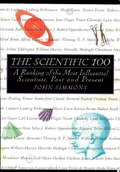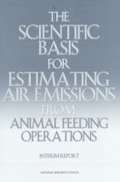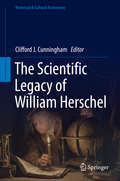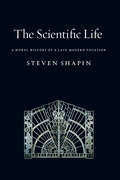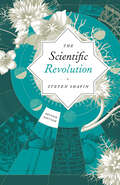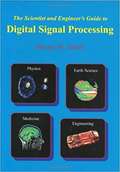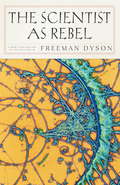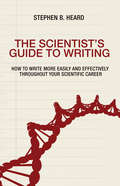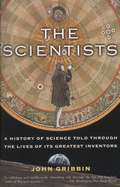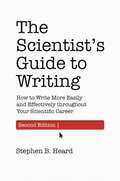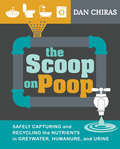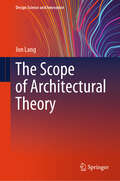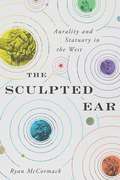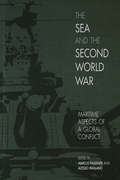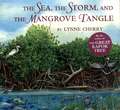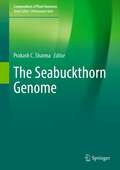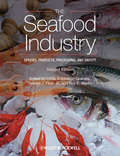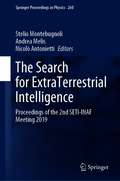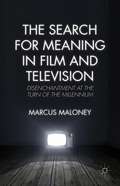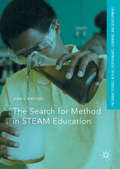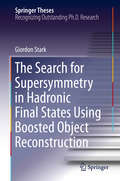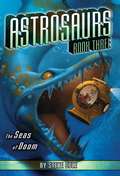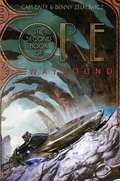- Table View
- List View
The Scientific 100
by Lynda Simmons John SimmonsWho are the great scientists throughout the ages, and what exactly did they do to earn their importance? From Archimedes to Newton to Einstein to Hawking, The Scientific 100 provides the fascinating answers. Vivid biographical sketches chronicle the lives and accomplishments of the world's preeminent scientists. And in the tradition of the Citadel Press 100 Series, they are ranked provocatively in order of influence--an inspiration for lively discussion.This unique volume is a browser's treasure trove and a handy reference for the general reader.John Simmons has been associated with Current Biography for more than fifteen years. He has written frequently about Nobel laureates in science. A member of the New York Academy of Sciences, he divides his time between New York City and Paris.
The Scientific Basis for Estimating Air Emissions from Animal Feeding Operations
by Ad Hoc Committee on Air Emissions from Animal Feeding OperationsThis is an interim report of the Ad Hoc Committee on Air Emissions from Animal Feeding Operations of the National Research Council's Committee on Animal Nutrition. The report focuses on identifying the scientific criteria needed to ensure that estimates of air emission rates are accurate, examining the basis for these criteria in the scientific literature, and assessing uncertainties associated with them. There is no subject index. Annotation (c)2003 Book News, Inc. , Portland, OR (booknews. com)
The Scientific Legacy of William Herschel
by Clifford J. CunninghamThis book presents a modern scholarly analysis of issues associated with England'smost famous astronomer, William Herschel. The world's leading experts onHerschel, discoverer of the planet Uranus, here offer their combined wisdom on manyaspects of his life and astronomical research. Solar system topics includecomets, Earth's Moon, and the spurious moons of Uranus, all objects whose observation was pioneered by Herschel. The contributors examine his study of thestructure of the Milky Way and an in-depth look at the development of the front view telescopes he built. The popular subject of extraterrestriallife is looked at from the point of view of both William Herschel and his sonJohn, both of whom had an interest in the topic. William's personal development through the educational system of the lateeighteenth-century is also explored, and the wide range of verse and satire invarious languages associated with his discoveries is collected here for thefirst time. Hershel worked at a time of incredible discovery, and his work is still highly regarded in the field. Here it is given a thorough investigation which puts into context and perspective his path breaking career.
The Scientific Life: A Moral History of a Late Modern Vocation
by Steven ShapinConventional wisdom has long held that scientists are neither better nor worse than anyone else, that personal virtue does not necessarily accompany technical expertise, and that scientific practice is profoundly impersonal. Shapin, however, here shows how the uncertainties attending scientific research make the virtues of individual researchers intrinsic to scientific work. Further, Shapin argues that the radical uncertainties of much of contemporary science have made personal virtues more central to its practice than ever before, and he also reveals how radically novel aspects of late modern science have unexpectedly deep historical roots.
The Scientific Revolution (science.culture)
by Steven Shapin“There was no such thing as the Scientific Revolution, and this is a book about it.” With this provocative and apparently paradoxical claim, Steven Shapin begins his bold, vibrant exploration of the origins of the modern scientific worldview, now updated with a new bibliographic essay featuring the latest scholarship. “An excellent book.”—Anthony Gottlieb, New York Times Book Review “Timely and highly readable. . . . A book which every scientist curious about our predecessors should read.”—Trevor Pinch, New Scientist “Shapin's account is informed, nuanced, and articulated with clarity. . . . This is not to attack or devalue science but to reveal its richness as the human endeavor that it most surely is. . . . Shapin's book is an impressive achievement.”—David C. Lindberg, Science “It's hard to believe that there could be a more accessible, informed or concise account. . . . The Scientific Revolution should be a set text in all the disciplines. And in all the indisciplines, too.”—Adam Phillips, London Review of Books
The Scientist And Engineer's Guide To Digital Signal Processing
by Steven W. SmithClear and concise explanations of practical DSP techniques. Written for scientists and engineers needing the power of DSP, but not the abstract theory and detailed mathematics.
The Scientist as Rebel
by Freeman J. DysonFrom Galileo to today's amateur astronomers, scientists have been rebels, writes Freeman J. Dyson. Like artists and poets, they are free spirits who resist the restrictions their cultures impose on them. In their pursuit of nature's truths, they are guided as much by imagination as by reason, and their greatest theories have the uniqueness and beauty of great works of art.Dyson argues that the best way to understand science is by understanding those who practice it. He tells stories of scientists at work, ranging from Isaac Newton's absorption in physics, alchemy, theology, and politics, to Ernest Rutherford's discovery of the structure of the atom, to Albert Einstein's stubborn hostility to the idea of black holes. His descriptions of brilliant physicists like Edward Teller and Richard Feynman are enlivened by his own reminiscences of them. He looks with a skeptical eye at fashionable scientific fads and fantasies, and speculates on the future of climate prediction, genetic engineering, the colonization of space, and the possibility that paranormal phenomena may exist yet not be scientifically verifiable. Dyson also looks beyond particular scientific questions to reflect on broader philosophical issues, such as the limits of reductionism, the morality of strategic bombing and nuclear weapons, the preservation of the environment, and the relationship between science and religion. These essays, by a distinguished physicist who is also a prolific writer, offer informed insights into the history of science and fresh perspectives on contentious current debates about science, ethics, and faith.
The Scientist's Guide to Writing: How to Write More Easily and Effectively throughout Your Scientific Career
by Stephen B. HeardThe ability to write clearly is critical to any scientific career. The Scientist's Guide to Writing provides practical advice to help scientists become more effective writers so that their ideas have the greatest possible impact.Drawing on his own experience as a scientist, graduate adviser, and editor, Stephen Heard emphasizes that the goal of all scientific writing should be absolute clarity; that good writing takes deliberate practice; and that what many scientists need are not long lists of prescriptive rules but rather direct engagement with their behaviors and attitudes when they write. He combines advice on such topics as how to generate and maintain writing momentum with practical tips on structuring a scientific paper, revising a first draft, handling citations, responding to peer reviews, managing coauthorships, and more.In an accessible, informal tone, The Scientist's Guide to Writing explains essential techniques that students, postdoctoral researchers, and early-career scientists need to write more clearly, efficiently, and easily.Emphasizes writing as a process, not just a productEncourages habits that improve motivation and productivityExplains the structure of the scientific paper and the function of each partProvides detailed guidance on submission, review, revision, and publicationAddresses issues related to coauthorship, English as a second language, and more
The Scientists: A History of Science Told Through the Lives of Its Greatest Inventors
by John GribbinA wonderfully readable account of scientific development over the past five hundred years, focusing on the lives and achievements of individual scientists, by the bestselling author of In Search of Schrödinger's Cat. In this ambitious new book, John Gribbin tells the stories of the people who have made science, and of the times in which they lived and worked. He begins with Copernicus, during the Renaissance, when science replaced mysticism as a means of explaining the workings of the world, and he continues through the centuries, creating an unbroken genealogy of not only the greatest but also the more obscure names of Western science, a dot-to-dot line linking amateur to genius, and accidental discovery to brilliant deduction. By focusing on the scientists themselves, Gribbin has written an anecdotal narrative enlivened with stories of personal drama, success and failure. A bestselling science writer with an international reputation, Gribbin is among the few authors who could even attempt a work of this magnitude. Praised as "a sequence of witty, information-packed tales" and "a terrific read" by The Times upon its recent British publication, The Scientists breathes new life into such venerable icons as Galileo, Isaac Newton, Albert Einstein and Linus Pauling, as well as lesser lights whose stories have been undeservedly neglected. Filled with pioneers, visionaries, eccentrics and madmen, this is the history of science as it has never been told before.
The Scientist’s Guide to Writing, 2nd Edition: How to Write More Easily and Effectively throughout Your Scientific Career
by Stephen B. HeardAn updated and expanded edition of the acclaimed writing guide for scientistsThe Scientist’s Guide to Writing explains the essential techniques that students, postdocs, and early-career scientists need to write more clearly, efficiently, and easily. Now fully updated and expanded, this incisive primer offers practical advice on such topics as generating and maintaining writing momentum, structuring a scientific paper, revising a first draft, handling citations, responding to peer reviews, managing coauthorships, and more. The ability to write clearly is critical to any scientific career. The Scientist’s Guide to Writing shows scientists how to become better writers so that their ideas have the greatest possible impact.New chapters discuss effective reading, choosing the right journal for your research, and the advantages and disadvantages of posting preprintsProvides additional advice on reporting statistical results, dealing with conflicting peer reviews, managing coauthorships, writing with English as an additional language, and moreEmphasizes writing as a process, not just a productEncourages habits that improve motivation and productivityOffers detailed guidance on submission, review, revision, and publicationIncludes a wealth of new exercises
The Scoop on Poop
by Dan ChirasFlush it and forget it is the plumbing mantra of the industrialized world. Most people just want sewage to go away, preferably without having to see, smell, or worse yet, touch it. But crap has a bad rap. Human waste is a valuable resource we can use to support food production. Blackwater, greywater, and solids are actually rich in organic matter, and alternative means of handling these "wastes" can conserve enormous quantities of fresh water for other uses.The Scoop on Poop presents a wide range of ways to answer the call of nature, and in so doing to maximize the benefits of existing waste water. This book explores proven alternatives to Western sanitation. Whether you're interested in composting toilets, outdoor grey- or blackwater planters, constructed wetlands, or other innovative solutions, author Dan Chiras will walk you through: System pros and cons Design, construction, and maintenance advice Costs, permitting issues, and the safe treatment of composted wasteAll system plans are relatively simple and straightforward enough for the average homeowner to build and install. Intended for readers who live in cities, towns and rural environments, this is a practical guide to safe, ingenious ways to capture the nutrients from waste and recycle them back into your soil to grow fruit trees, vegetables, and flowers--all without running afoul of the "ick" factor. Dan Chiras is the author of over thirty books on residential renewable energy and green building, and is the director of the Evergreen Institute's Center for Renewable Energy and Green Building.
The Scope of Architectural Theory (Design Science and Innovation)
by Jon LangThis book comprehensively lays out the knowledge base required for architectural practice and education at a time when artificial intelligence (AI) algorithms are shaping the way architects think. Architects with a desire to retain their creative role in the design of buildings and urban spaces must understand and articulate the theoretical bases of their work and what it can achieve. This book provides a clear structure and outline of both the functional and procedural theoretical base for architects to employ in their work. It offers an intellectually rigorous basis that allows architects to understand the evolution of architecture through history as well as the advocacies of individual architects. It provides them with the scope of architectural theory necessary for designing for the future. The book can be a valuable reference for researchers and professionals interested in architectural theory and allied fields.
The Sculpted Ear: Aurality and Statuary in the West (Perspectives on Sensory History #2)
by Ryan McCormackSound and statuary have had a complicated relationship in Western aesthetic thought since antiquity. Taking as its focus the sounding statue—a type of anthropocentric statue that invites the viewer to imagine sounds the statue might make—Sculpted Ears rethinks this relationship in light of discourses on aurality emerging within the field of sound studies. Ryan McCormack argues that the sounding statue is best thought of not as an aesthetic object but as an event heard by people and subsequently conceptualized into being through acts of writing and performance.Constructing a history in which hearing plays an integral role in ideas about anthropocentric statuary, McCormack begins with the ancient sculpture of Laocoön, before moving to a discussion of the early modern automaton known as Tipu’s Tiger and the statue of the Commendatore in Mozart’s Don Giovanni. Finally, he examines statues of people from the present and the past, including the singer Josephine Baker, the violinist Aleksandar Nikolov, and the actor Bob Newhart—with each case touching on some of the issues that have historically plagued the aesthetic viability of the sounding statue. McCormack convincingly demonstrates how sounding statues served as important precursors and continuing contributors to modern ideas about the ontology of sound, technologies of sound reproduction, and performance practices blurring traditional divides between music, sculpture, and the other arts.A compelling narrative that illuminates the stories of individual sculptural objects and the audiences that hear them, this book will appeal to anyone interested in the connections between aurality and statues in the Western world, in particular scholars and students of sound studies and sensory history.
The Sculpted Ear: Aurality and Statuary in the West (Perspectives on Sensory History)
by Ryan McCormackSound and statuary have had a complicated relationship in Western aesthetic thought since antiquity. Taking as its focus the sounding statue—a type of anthropocentric statue that invites the viewer to imagine sounds the statue might make—The Sculpted Ear rethinks this relationship in light of discourses on aurality emerging within the field of sound studies. Ryan McCormack argues that the sounding statue is best thought of not as an aesthetic object but as an event heard by people and subsequently conceptualized into being through acts of writing and performance.Constructing a history in which hearing plays an integral role in ideas about anthropocentric statuary, McCormack begins with the ancient sculpture of Laocoön before moving to a discussion of the early modern automaton known as Tipu’s Tiger and the statue of the Commendatore in Mozart’s Don Giovanni. Finally, he examines statues of people from the present and the past, including the singer Josephine Baker, the violinist Aleksandar Nikolov, and the actor Bob Newhart—with each case touching on some of the issues that have historically plagued the aesthetic viability of the sounding statue. McCormack convincingly demonstrates how sounding statues have served as important precursors and continuing contributors to modern ideas about the ontology of sound, technologies of sound reproduction, and performance practices blurring traditional divides between music, sculpture, and the other arts.A compelling narrative that illuminates the stories of individual sculptural objects and the audiences that hear them, this book will appeal to anyone interested in the connections between aurality and statues in the Western world, in particular scholars and students of sound studies and sensory history.
The Sea and the Second World War: Maritime Aspects of a Global Conflict (New Perspectives on the Second World War)
by Marcus Faulkner and Alessio PatalanoAn in-depth study of World War II&’s naval operations. &“Rarely does a collection of essays offer so many new and persuasive assessments. Well done!&”—Professor David Snead, Liberty University The sea shaped the course and conduct of World War II, from the first moments of the German invasion of Poland on September 1, 1939, to the Japanese surrender on September 2, 1945. The impact could be felt far beyond the shoreline, as the arms and armies carried across the oceans were ultimately destined to wage war ashore. Populations and industries depended on the raw materials and supplies in a war that increasingly became a contest of national will and economic might. Ultimately, it was the war at sea that linked numerous regional conflicts and theaters of operation into a global war. As the war grew in complexity and covered an increasingly larger geographical area, the organization of the maritime effort and the impact it had on the formulation of national strategy also evolved. This volume illustrates the impact of naval operations on the Second World War by highlighting topics previously neglected in the scholarship. In doing so, it provides new insights into political, strategic, administrative, and operational aspects of the maritime dimension of the war. &“A fine collection of essays by some of the leading scholars in the field. The book addresses comprehensively the vital importance of the sea across a range of theaters during the Second World War through a diverse selection of case studies. The examinations and re-examinations in this volume will be of interest to both scholars and practitioners.&”—Dr. Steven Paget, University of Portsmouth
The Sea, The Storm, And The Mangrove Tangle
by Lynne CherryA look into a unique ecosystem, one that is endangered in many places <P> A seed is jostled from a branch of a mangrove tree and floats to a lagoon in the Caribbean Sea. It takes root, sprouts leaves, and slowly begins to grow. Over many years, the mangrove will provide a home and nourishment for numerous creatures of land and sea. Among its roots come to live fiddler crabs and shrimp; in its branches dwell lizards and hummingbirds. Soon the tree is dropping seeds of its own, and other mangroves are growing, creating a tangle whose benefits extend even to large mammals like dolphins and manatees. There are endpaper maps that indicate where mangroves are located and the names of common animals and plants found in them. <P> Ever threatened by hurricanes and even more by human destruction, the mangroves of our planet are endangered, but in Lynne Cherry's richly illustrated story one such habitat survives, giving readers hope and inspiration for preservation of these ecosystems in the real world.
The Seabuckthorn Genome (Compendium of Plant Genomes)
by Prakash C. SharmaThis work is the first compilation of comprehensive deliberations on botany, cytogenetics and sex determination, genetic resources and diversity, classical breeding, molecular markers and genome sequence resources, and application of omics technology including transcriptomics, proteomics, and metabolomics resources in the multipurpose medicinal plant seabuckthorn. The book also presents a detailed narrative on antioxidative, radioprotective nutraceutical, and medicinal applications of seabuckthorn products. A detailed treatment has been included on analytical techniques and processing technologies. Altogether, the book contains about 300 pages over 17 chapters contributed by globally reputed experts on the relevant field in this important plant species. This book will be useful to the research students, teachers, and scientists in the academia and private sector engaged in horticulture, genetics, breeding, molecular biology, biotechnology, and breeding. The book will also be a useful source for workers involved in the development of plant-based medicines, nutraceuticals, therapeutics, and cosmeceuticals and extension workers involved in the development of rural farmers and small-scale industries.
The Seafood Industry: Species, Products, Processing, and Safety
by Jr. Roy E. Martin Linda Ankenman Granata George J. FlickThe Seafood Industry: Species, Products, Processing, and Safety, Second Edition is a completely updated and contemporary revision of Flick and Martin’s classic publication, The Seafood Industry. Covering all aspects of the commercial fish and shellfish industries – from harvest through consumption – the book thoroughly describes the commercial fishery of the western hemisphere. The international audience will also find the coverage accessible because, although species and regulations may differ, the techniques described are similar worldwide,. The second edition contains a significant expansion of the material included in the first edition. Examples include: high pressure processing; inclusion of additional major crustacean species of commerce; fishery centers and development programs; handling methods on fishing vessels; and new chapters on Toxins, Allergies, and Sensitivities; Composition and Quality; and Risk Management and HACCP; and Processing Fin Fish. The Seafood Industry: Species, Products, Processing, and Safety, comprehensive in scope and current with today’s issues, will prove to be a great asset to any industry professional or seafood technologist working in the field.
The Search for ExtraTerrestrial Intelligence: Proceedings of the 2nd SETI-INAF Meeting 2019 (Springer Proceedings in Physics #260)
by Stelio Montebugnoli Andrea Melis Nicolò AntoniettiThis book presents the latest knowledge of the newly discovered Earth-like exoplanets and reviews improvements in both radio and optical SETI. A key aim is to stimulate fresh discussion on algorithms that will be of high value in this extremely complicated search. Exoplanets resembling Earth could well be able to sustain life and support the evolution of technological civilizations, but to date, all searches for such life forms have proved fruitless. The failings of SETI observations are well recognized, and a new search approach is necessary. In this book, different detection algorithms that exploit state-of-the-art, low-cost, and extremely fast multiprocessors are examined and compared. Novel methods such as the agnostic entropy and high-sensitivity blind signal extraction algorithms should represent a quantum leap forward in SETI. The book is of interest to all researchers in the field and hopefully stimulates significant progress in the search for extraterrestrial intelligence.
The Search for Meaning in Film and Television
by Marcus MaloneyThis fascinating study explores the difficulties faced by modern Westerners in their search for a meaningful life. It sheds light on this enduring cultural dilemma through a close reading of four popular film and television narratives: Pixar's animated feature film, Toy Story; Christopher Nolan's Batman Begins and The Dark Knight; the television romantic comedy, Sex and the City; and, finally, the mobster drama, The Sopranos. The readings are guided by a number of inter-related questions. First, in what ways do these popular stories speak to the modern West's meaning dilemma? What do they have to say about contemporary culture, and its capacity to illuminate the fundamental human questions? What are the core problems faced by the central characters and how are they resolved? Finally, and perhaps most importantly, do the four stories that come into focus suggest hope or despair in the modern West's search for meaning?
The Search for Method in STEAM Education
by Jaime E. MartinezThis book explores various approaches to building a positive interdisciplinary STEAM (science, technology, engineering, arts and math) learning environment, as described by educators across the K-20 educational ladder. Crucial to their success, Martinez finds, is the playful and performatory approach they employ in their teaching. Their practices are creative, improvisational, and inclusive, and are shared in detail through illustrations and interviews. Throughout the book, the author explores a Vygotskian cultural performatory approach to creating interdisciplinary STEAM learning environments, drawing out the history of this approach and its success in fostering collaboration, creativity, leadership, and communication skills, as well as its effect on social, emotional, and cognitive growth in both formal and informal educational settings.
The Search for Supersymmetry in Hadronic Final States Using Boosted Object Reconstruction (Springer Theses)
by Giordon StarkThis thesis represents one of the most comprehensive and in-depth studies of the use of Lorentz-boosted hadronic final state systems in the search for signals of Supersymmetry conducted to date at the Large Hadron Collider. A thorough assessment is performed of the observables that provide enhanced sensitivity to new physics signals otherwise hidden under an enormous background of top quark pairs produced by Standard Model processes. This is complemented by an ingenious analysis optimization procedure that allowed for extending the reach of this analysis by hundreds of GeV in mass of these hypothetical new particles. Lastly, the combination of both deep, thoughtful physics analysis with the development of high-speed electronics for identifying and selecting these same objects is not only unique, but also revolutionary. The Global Feature Extraction system that the author played a critical role in bringing to fruition represents the first dedicated hardware device for selecting these Lorentz-boosted hadronic systems in real-time using state-of-the-art processing chips and embedded systems.
The Seas of Doom
by Steve Cole Woody FoxSomething very big and very dangerous is swimming in the seas of planet Aqua Minor. It's destroying all of the fish factories and making mincemeat out of all the submarines. So Captain Teggs and the brave crew on the DSS Sauropod set off to investigate. What do they find? A gigantic liopleurodon has made Aqua Minor its home. At first all the evidence points to him as the culprit behind the mass destruction. But then new evidence is uncovered that shows it couldn't be the liopleurodon. Is another monster lurking beneath the seas as well?
The Seas of Doom
by Steve Cole Woody FoxSomething very big and very dangerous is swimming in the seas of planet Aqua Minor. It's destroying all of the fish factories and making mincemeat out of all the submarines. So Captain Teggs and the brave crew on the DSS Sauropod set off to investigate. What do they find? A gigantic liopleurodon has made Aqua Minor its home. At first all the evidence points to him as the culprit behind the mass destruction. But then new evidence is uncovered that shows it couldn't be the liopleurodon. Is another monster lurking beneath the seas as well?
The Second Book of Ore: Waybound (The Books of Ore #2)
by Benny Zelkowicz Cam BaityPhoebe Plumm and Micah Tanner are a long way from home and entrenched in a struggle with no end in sight. The Foundry, an all-powerful company that profits off the living metal creatures of Mehk, is unleashing a wave of devastating attacks to crush the rebel army of mehkans known as the Covenant and capture Phoebe and Micah, dead or alive. But the Covenant believes that their ancient god, Makina, has chosen Phoebe for a sacred task: to seek the Occulyth, a mysterious object they hope can turn the tide against the Foundry. With her father gone, Phoebe's once unshakable determination is broken, and while Micah tries to uphold the vow he made to protect her no matter the cost, their enemies are closing in and time is running out.
